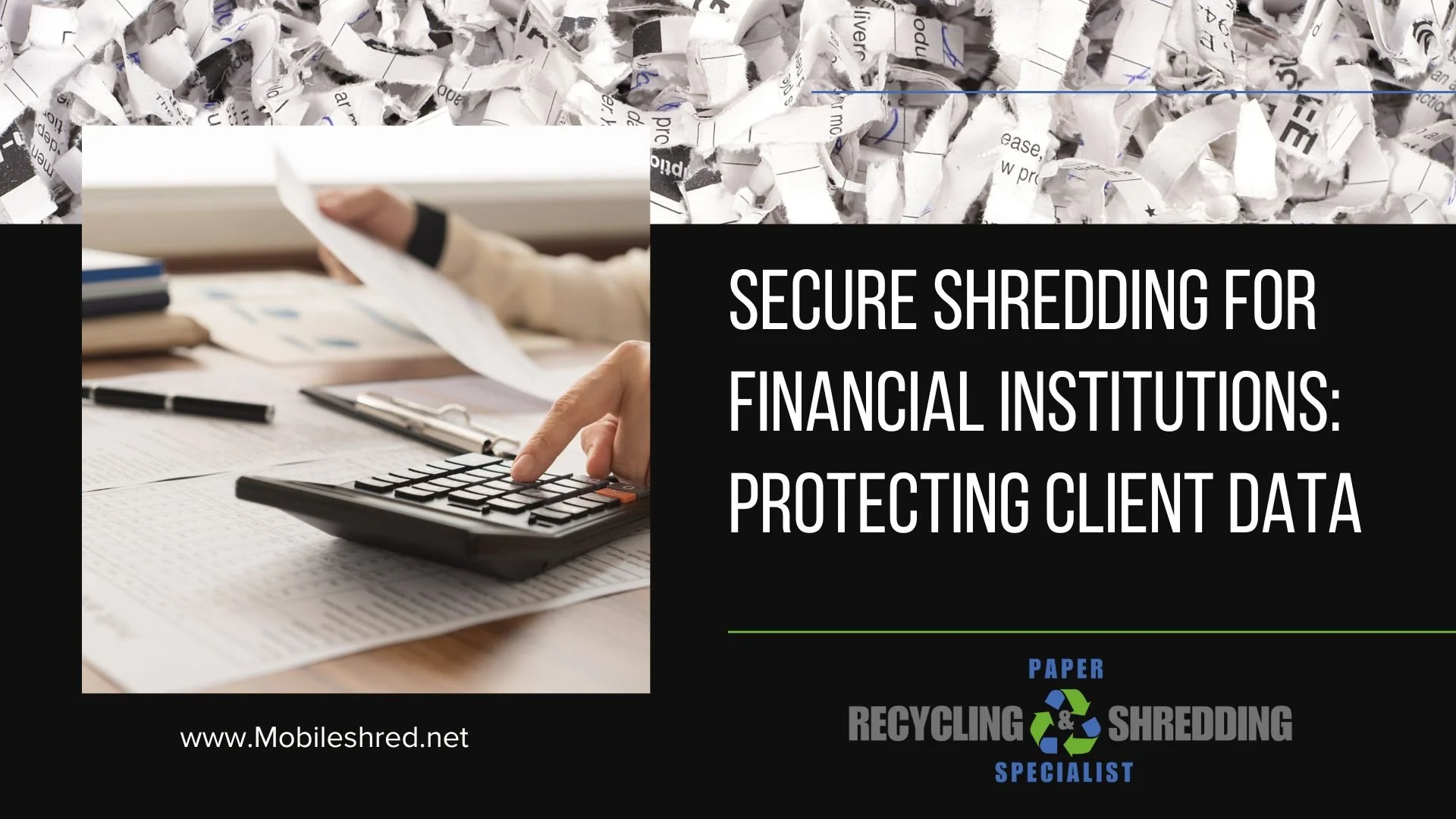Secure Shredding for Financial Institutions: Protecting Client Data
In the financial industry, safeguarding sensitive client data is not optional—it’s essential. Banks, credit unions, and other financial institutions manage vast amounts of confidential information daily, from account details to Social Security numbers. Mishandling this information can lead to legal repercussions, identity theft, and loss of trust. Secure shredding services are a critical component of protecting sensitive documents and ensuring regulatory compliance.
This expanded guide delves into why secure shredding is vital for financial institutions, the types of documents that should be destroyed, and how partnering with Paper Recycling & Shredding Specialists (PRSS) can keep your institution compliant and your clients’ information secure.
Why Secure Shredding Is Non-Negotiable in the Financial Sector
Compliance with Data Protection Regulations
Financial institutions are subject to stringent laws and industry regulations designed to protect customer information. Some key regulations include:
Gramm-Leach-Bliley Act (GLBA): Requires financial institutions to implement safeguards for customer information, including secure disposal.
FACTA Disposal Rule: Mandates the proper destruction of consumer report information to prevent unauthorized access.
SEC and FINRA Regulations: Require strict confidentiality measures for handling and disposing of financial documents.
Non-compliance can result in:
Hefty fines and penalties.
Lawsuits from affected clients.
Suspension of operational licenses.
Preventing Identity Theft
Improper disposal of financial records leaves sensitive client data vulnerable to identity thieves. Secure shredding ensures that information like account numbers, loan details, and credit reports are irretrievable, reducing the risk of fraud and theft.
Maintaining Client Trust
Trust is the cornerstone of financial relationships. A breach of client data can tarnish your reputation and lead to lost business. Implementing secure shredding practices demonstrates your institution’s commitment to protecting client privacy and complying with legal standards.
What Documents Need to Be Shredded?
To ensure compliance and protect sensitive information, financial institutions should securely destroy the following documents when no longer needed:
Bank Records: Statements, canceled checks, and account details.
Loan Applications: Personal data, credit reports, and financial history.
Customer Identification Forms: ID verification documents, such as driver’s licenses and Social Security cards.
Internal Financial Reports: Budgets, forecasts, and audits.
Customer Correspondence: Any letters or notices containing sensitive information.
How PRSS Ensures Secure Shredding for Financial Institutions
NAID AAA Certification
PRSS is certified by the National Association for Information Destruction (NAID), ensuring that our shredding processes meet or exceed industry standards for security and compliance.
Customizable Shredding Plans
Whether you need a one-time purge or recurring shredding services, PRSS offers flexible solutions tailored to your specific needs. Choose from:
On-Site Shredding: Documents are destroyed at your location for maximum security.
Off-Site Shredding: Documents are securely transported to our facility for destruction.
Locked Security Bins
We provide tamper-proof collection bins to ensure that sensitive documents remain secure until shredding.
Secure Chain of Custody
From the moment we collect your documents to the time they are destroyed, we maintain a documented chain of custody. This ensures compliance with GLBA, FACTA, and other regulations.
Eco-Friendly Practices
All shredded paper is baled and sent to recycling facilities, reducing your environmental footprint and supporting sustainability initiatives.
The Risks of Improper Document Disposal
Failing to securely destroy sensitive financial documents can result in:
Data Breaches: Unauthorized access to financial records can lead to identity theft and financial fraud.
Regulatory Penalties: Violations of GLBA, FACTA, or other regulations can incur fines ranging from thousands to millions of dollars.
Loss of Trust: A single incident of improper disposal can harm your institution’s reputation and lead to client attrition.
How the PRSS Shredding Process Works
Initial Consultation:
Contact PRSS to discuss your shredding needs and create a tailored plan.
Document Collection:
Secure collection bins are placed in your facility for easy and safe document storage.
Shredding:
On-site or off-site shredding options are available, ensuring compliance and convenience.
Certificate of Destruction:
After shredding, you’ll receive a Certificate of Destruction to document compliance with regulatory standards.
Recycling:
Shredded materials are recycled, contributing to environmental sustainability.
Linking to Helpful Resources
For more insights into financial data protection, visit:
For PRSS services, explore:
On-Site Shredding Services
Key Takeaways
Compliance Matters: Adhering to GLBA, FACTA, and other regulations protects your institution from legal penalties.
Prevent Identity Theft: Secure shredding eliminates the risk of sensitive data falling into the wrong hands.
Choose Certified Providers: Work with NAID AAA-certified shredding providers like PRSS to ensure security and compliance.
Maintain Client Trust: Demonstrating your commitment to data protection fosters loyalty and confidence among clients.
Sustainability Counts: PRSS’s recycling efforts support your institution’s environmental goals.
Get Started Today
Ensure compliance and safeguard client data with secure shredding services from PRSS. Contact us today for a free consultation or to schedule shredding services tailored to your needs. Call 877-747-3372 or visit our website.

